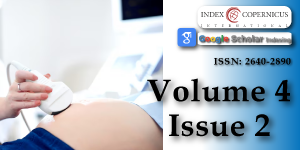Synergistic interactions of sperm impairing bacteria: Impact on pregnancy outcome in mouse model
Main Article Content
Abstract
Earlier in our laboratory, the role of various individual sperm impairing microorganisms on sperm parameters and female infertility has been elucidated at higher doses. As, multiple bacterial species tend to exert more pathogenic effect in comparison to single organism hence, present study was carried out to evaluate that if consortia of these sperm impairing organisms can lead to infertility in female mice at sub fertility dose. For this, impact of individual bacterial strains of Escherichia coli, Pseudomonas aeruginosa, Pseudomonas aeruginosa, Klebsiella pneumoniae and consortia of Escherichia coli and Pseudomonas aeruginosa, Escherichia coli and Pseudomonas aeruginosa, Escherichia coli and Klebsiella pneumoniae was examined on the motility, viability of mouse spermatozoa and fertility outcome. The results showed that the individual bacterial strains of E. coli, S. marcescens and K. pneumoniae could led to immobilization of spermatozoa by agglutination and P. aeruginosa led to immobilization of spermatozoa without agglutination. Also, all of them led to 100% sperm death in 45 min of incubation. In case of consortia of bacterial strains, the results showed sperm agglutination in all the cases and they were able to induce 100% sperm death at 30 min of incubation time. Further, in vivo studies were carried out to evaluate the impact of individual bacterial strains and consortia of bacterial strains on the fertility outcome in female Balb/c mice. For this, female mice were administered intravaginally with 101 cfu/20µl of individual bacterial strains or consortia of strains for 10 consecutive days or PBS. The results showed that both individual bacterial strains and consortia of bacterial strains were able to efficiently colonize the mouse vagina. Further, control group receiving phosphate buffer saline and groups receiving individual bacterial strains showed all the pregnancy related changes viz. abdominal distension, string of pearls on palpation as well as delivery of pups on completion of gestation period and delivery of pups. The histological examination of reproductive organs viz. uterus and ovary, of the female mice receiving PBS or individual bacterial strains showed the formation of corpus luteum in the ovary and the formation of decidua’s in the uterus, indicative of pregnancy. However, mice receiving consortia of bacterial strains did not show any pregnancy related changes throughout the experiment. Thus, these results indicate that the presence of consortia of sperm impairing microorganisms in vaginal milieu is efficient in provoking infertility even at subfertility doses.
Article Details
Copyright (c) 2021 Jangra I, et al.

This work is licensed under a Creative Commons Attribution 4.0 International License.
Gilbert JA, Quinn RA, Debelius J, Xu ZZ, Morton J, et al. Microbiome-wide association studies link dynamic microbial consortia to disease. Nature. 2016; 535: 94-103. PubMed: https://pubmed.ncbi.nlm.nih.gov/27383984/
Bakaletz LO. Viral potentiation of bacterial superinfection of the respiratory tract. Trends Microbiol. 1995; 3: 110-114. PubMed: https://pubmed.ncbi.nlm.nih.gov/7773588/
Kuramitsu HK, He X, Lux R, Anderson MH, Shi W. Interspecies interactions within oral microbial communities. Microbiol Mol Biol Rev. 2007; 71: 653-670. PubMed: https://pubmed.ncbi.nlm.nih.gov/18063722/
Brogden KA, Guthmiller JM. Polymicrobial diseases, a concept whose time has come. ASM News-American Society for Microbiology. 2003; 69: 69-73. PubMed: https://pubmed.ncbi.nlm.nih.gov/21735561/
Emmens CW. The motility and viability of rabbit spermatozoa at different hydrogen ion concentrations. J Physiol. 1947: 471-481. PubMed: https://pubmed.ncbi.nlm.nih.gov/16991777/
Korgaonkar A, Trivedi U, Rumbaugh KP, Whiteley M. Community surveillance enhances Pseudomonas aeruginosa virulence during polymicrobial infection. Proc Natl Acad Sci USA. 2013; 110: 1059-1064. PubMed: https://pubmed.ncbi.nlm.nih.gov/23277552/
Lamont RF, Sobel JD, Akins RA, Hassan SS, Chaiworapongsa T, et al. The vaginal microbiome: new information about genital tract flora using molecular based techniques. BJOG. 2011; 118: 533-549. PubMed: https://pubmed.ncbi.nlm.nih.gov/21251190/
Anchanadevi C. Molecular characterization of pathogens isolated from endometrial samples of female infertility cases. Int J Recent Sci Res. 2013; 4: 614-618.
Campisciano G, Florian F, D'Eustacchio A, Stanković D, Ricci G, et al. Subclinical alteration of the cervical–vaginal microbiome in women with idiopathic infertility. J Cellular Physiol. 2017; 232: 1681-1688. PubMed: https://pubmed.ncbi.nlm.nih.gov/28098358/
Weinberg M, Prévot AR, Davesne J, Renard C. The microbial flora of appendicitis. Comptes Rendus de la Sociiti de Biologie, Paris. 1928; 98: 749.
Carlson E. Effect of strain of Staphylococcus aureus on synergism with Candida albicans resulting in mouse mortality and morbidity. Infection and Immunity.1983; 42: 285-292. PubMed: https://www.ncbi.nlm.nih.gov/pmc/articles/PMC264556/
Kelly MJ. The quantitative and histological demonstration of pathogenic synergy between Escherichia coli and Bacteroides fragilis in guinea-pig wounds. J Medi Microbiol. 1978; 11: 513-523. PubMed: https://pubmed.ncbi.nlm.nih.gov/364068/
Carlson E. Synergistic effect of Candida albicans and Staphylococcus aureus on mouse mortality. Infection and immunity.1982; 38: 921-924. PubMed: https://www.ncbi.nlm.nih.gov/pmc/articles/PMC347837/

